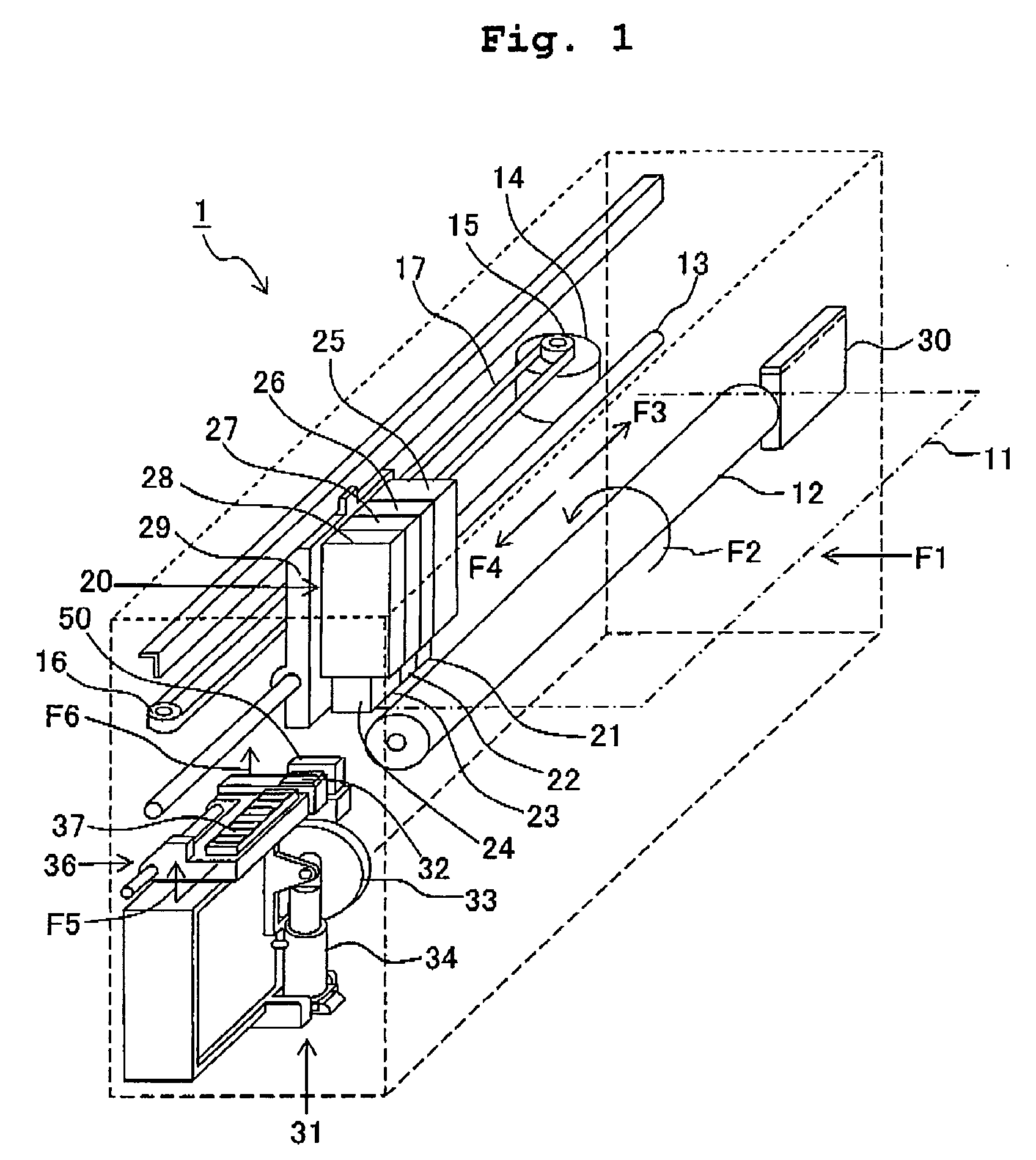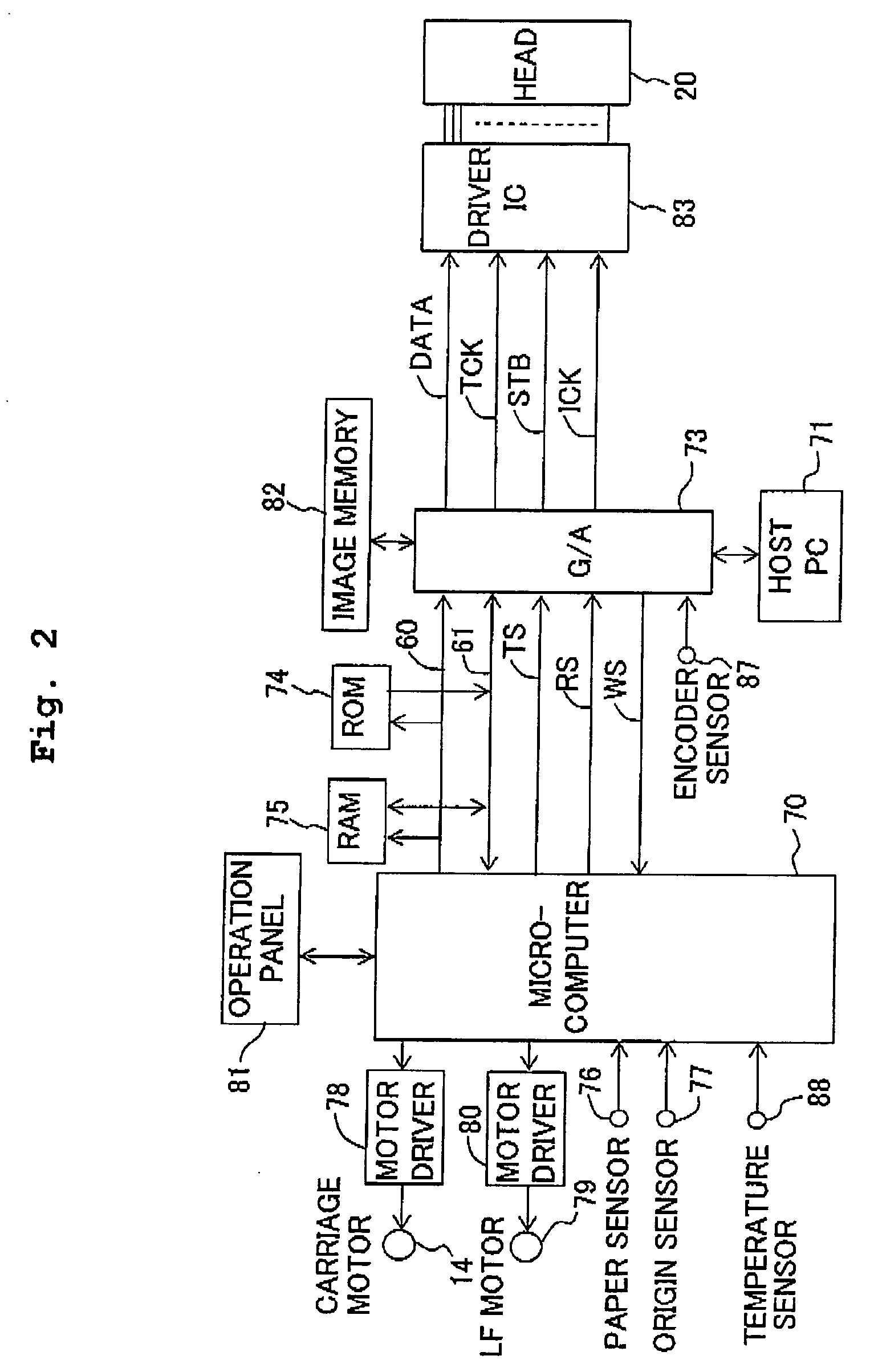[0021] In these cases, one of the difference between the first temperature of the ink detected at the first timing and the second temperature of the ink detected at the second timing and the difference between the first drive voltage at the first timing which is determined based on the first temperature of the ink detected at the first timing and the temporary drive voltage set based on the second temperature of the ink detected at the second timing is calculated; and the second drive voltage at the second timing is determined based on one of the calculated differences. Therefore, even when the temperature of the ink is changed suddenly, the drive voltage does not change suddenly. Consequently, even when the temperature of the ink is changed suddenly depending on the situation in which the ink-jet head is driven or the environment in which the ink-jet head is used during the recording, it is possible to maintain a satisfactory recording quality. Further, it is possible to arbitrarily set a time interval between the first timing and the second timing, and by making this time interval shorter than a recording interval of time during which each of the pages is printed, it is possible to
handle the change in the ink temperature during the recording of one page.
[0023] when the difference is greater than the predetermined value, the drive voltage-determining section may determine a drive voltage, which is made to be close, from the first drive voltage at the first timing, to the temporary drive voltage by only a value smaller than a difference voltage between the first drive voltage at the first timing and the temporary drive voltage, to be the second drive voltage at the second timing. In these cases, even when the ink temperature is changed at the first timing and the second timing, it is possible to perform the recording by using the drive voltage according to the change in the ink temperature, thereby improving the recording quality. In other words, when there is a substantial change in the ink temperature at the first timing and the second timing, the present invention uses a drive voltage, obtained by bringing the first drive voltage at the first timing close to the temporary drive voltage, rather than using the temporary drive voltage set based on the second temperature of the ink detected at the second timing, as it is. Therefore, it is possible to prevent the drive voltage from undergoing a substantial change, and to avoid a decline in the recording quality. For example, when the drive voltage is decreased, a volume of an ink droplet which is discharged becomes smaller and a
discharge speed is decreased, thereby decreasing the
recording density. This in turn causes the decrease in the recording quality because when the drive voltage is suddenly decreased substantially at the first timing and the second timing, there arises a contrasting difference (shade difference) between a recording area performed at the first timing and a recording area performed at the second timing. However, according to the ink-jet recording apparatus and the recording method of the present invention, the drive voltage does not decrease substantially at the first timing and the second timing. Therefore, the contrasting difference does not occur between the recording area of the first timing and the recording area of the second timing, thereby making it possible to improve the recording quality.
[0024] In the ink-jet recording apparatus and the recording method of the present invention, the drive voltage-determining section may determine the second drive voltage at the second timing, at every first time interval, during a predetermined period of time from a start of recording; and when the predetermined period of time is elapsed, the drive voltage-determining section may determine the second drive voltage at the second timing at every second time interval which is longer than the first time interval. The ink temperature tends to increase, during the predetermined period of time from the start of recording, as the recording time is increased; and after the predetermined period of time is elapsed, the ink temperature tends to increase gradually. Consequently, rather than determining the drive voltage at a same interval irrespective of the time elapsed after the start of recording, the drive voltage is determined, at every first time interval, during the predetermined period of time after the start of recording; and after the predetermined period of time is elapsed, the drive voltage is determined at every second time interval which is longer than the first time interval, thereby making it possible to determine a drive voltage which is optimum for a change in a
viscosity of ink accompanying with the increase in the ink temperature. In the ink-jet recording apparatus and the recording method of the present invention, by setting an interval for determining the drive voltage to a short time interval (first time interval) during a predetermined period of time in which the temperature of the ink rises in accordance with the increase in the recording time. Accordingly, it is possible to use the optimum drive voltage corresponding to the temperature of the ink, thereby improving the recording quality. Further, after the predetermined period of time is elapsed and during the period of time in which the rise in the temperature of ink is gradual, the interval for determining the drive voltage is set to be a longer time interval (second time interval), thereby making it possible to prevent the determination of the drive voltage from being performed unnecessarily many times. For example, as will be explained in an embodiment to be described later on, when a
microcomputer executes a process for determining the drive voltage, it is possible to reduce a number of processes (steps) for determining the drive voltage. Accordingly, it is possible to reduce a load on a
microcomputer.
[0026] In the ink-jet recording apparatus and the recording method, there may be included further a table in which drive voltages are set for a plurality of temperature ranges, respectively. Further, when the difference is greater than the predetermined value, a drive voltage between the first drive voltage at the first timing and the temporary drive voltage set at the second timing may be read from the table, and the read drive voltage may be determined to be the second drive voltage at the second timing. For example, in a case provided with the table in which the drive voltages are set to decrease in accordance with the rise in the ink temperature, when a difference (V1−V2′) between the first drive voltage (V1) at the first timing and the temporary drive voltage (V2′) set at the second timing is a positive value, and an absolute value of the difference is greater than the predetermined value, a drive voltage closer to the first drive voltage (V1) at the first timing than the temporary drive voltage (V2′) set at the second timing, namely, a drive voltage which is lower than the first drive voltage at the first timing but which is higher than the temporary drive voltage (V2′) set at the second timing may be read from the table, and the read drive voltage may be determined to be the second drive voltage (V2) at the second timing. By doing so, it is possible to easily read the drive voltage which is to be set at the second timing. Further, in these cases, there is no fear that the recording quality is declined due to a substantial change in the drive voltage.
[0027] In the ink-jet recording apparatus and the recording method, the drive voltage-determining section may determine the second drive voltage at the second timing every time a scanning of the recording-objective medium is performed by the ink-jet head for a predetermined number of times. In these cases, even when a recording area having a low
recording density and a recording area having a high
recording density are present in one recording-objective medium in a mixed manner, it is possible to use a drive voltage optimum for the temperature of the ink which is fluctuated (changed) due to the change in the recording density, thereby making it possible to improve the recording quality.
 Login to View More
Login to View More  Login to View More
Login to View More 


